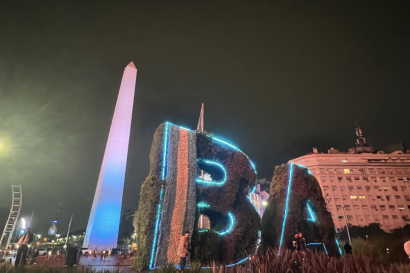This past weekend I visited one of the most magnificent and awe-inspiring places in the world: Iguazu Falls. Puerto Iguazu, the town right outside of the national park, lies on the border of Argentina facing Panama and Brazil. When you walk to the end of the street 3 Fronteras, you are met with the sight of Brazil and Panama—each only a stone’s throw away from the Argentine border. In such hostile political times, seeing three countries come together with no walls brings a sense of peace that’s been missing from the world. The river, calmly flowing past each country, acts as a glue bringing together different cultures, languages, and histories. Downriver, the sight of Iguazu Falls brings a different sense of peace. The waterfalls are located between Argentina and Brazil, sharing the river that houses boat tours for a much more intimate view of the falls. Standing beneath the largest waterfall system in the world, everything else seems to fade away. The pure strength and beauty of nature comes into perspective when you feel and hear the roar of the water spilling into the mouth of the river. Driving through the waterfalls on a speed boat between Brazil and Argentina, life seemed much more like a dream. I felt like a child having the time of their life with no worries—existing in a paradise between two countries, a solace from the rest of the world. With fresh water on my face and wind in my hair, a sense of clarity dawned on me that only nature can bring.
__________________________________
Being here just over a month (I really don’t know where the time has gone), there has been one thing that has been I have noticed in throughout my time here: the lack of diversity. Diversity can be applied to many different subjects, but here, I am referring for diversity of outward characteristics (i.e. body shape, ethnicity/race, etc.). I take the street Santa Fe every day to class. It is filled with all sorts of shops selling jewelry, shoes, cell phone accessories, and of course clothing. Having a strong affinity for window shopping (and sometimes actually shopping), I have stepped into several these stores. When browsing the shelves and racks of clothing, I am met with the manifestation of the body ideal in Buenos Aires. I pick up the largest pair of pants and realize that I would never be able to fit in them—it’s physically impossible for my body to be that small and still healthy. I consider myself a pretty average body shape; I am not super tall, nor thin, nor large—someone that can typically find their size at any given store in the United States (a privilege I realize that not all have). Although there has been recent legislation to include larger sizes in stores, it still seems that only a select body type can shop in these stores.
Outside on the streets of Buenos Aires, the diversity in ethnicity is also lacking. From what I have gathered, Argentines have an immense pride of being immigrants mainly from Spain and Italy. This migration of Europeans has created a distinctly unique culture—something of a mix of Italian, Spanish, and Latin influence. Within this culture, there is a strong lack of racial and ethnic diversity (though the concept of race is something very abstract and different in Argentina to what we have come to know in the United States). I have noticed there are very few people in Buenos Aires who are not of European descent and would be white-passing in the United States—it’s quite an odd feeling to be a darker-skinned Latina in a Euro-centric Latin country. This ethnic makeup of the country, and more specifically Buenos Aires, has intrigued me since I first arrived. However, even more intriguing is how Argentines regard the concept of ethnicity and minority groups. There seems to be a collective agreement that ethnic/racial origins are not as important as other social identities such as class or nationality; this has much to do with the history of Argentina—the lack of slavery, the high regard for European culture, the assimilation of immigrants to be “Argentine”. Growing up in a country where race and the color of your skin was (and often still is), THE defining characteristic of one’s social identity, I cannot quite wrap my mind around the lack of awareness for ethnicity and race. For now, I chalk it up to cultural differences though would love to find an Argentine to discuss this topic more at length with.

Elizabeth Azevedo
<p>Come one, come all on this adventure of a lifetime! I'm Elizabeth, known to many as Liz and Avocado by some. Originally from Northern California, I am currently studying Communication Studies and American Culture at the University of Michigan - Ann Arbor. I've decided to take my education beyond the bounds of the United States and head to Buenos Aires, Argentina!! Follow me along this journey as I navigate a new country and try to remember Spanish!</p>







